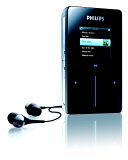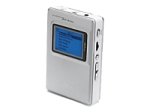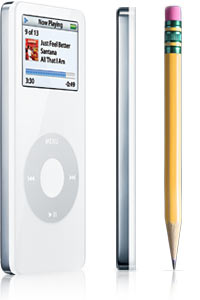Music Players

It seems that music player manufacturers who take on Apple are forever fighting a losing battle. For just as it seems a chink appears in the iPod's armour, Apple raises the bar by introducing a new series of players, adding innovative features or dropping the price.
Philips is the latest manufacturer to have a crack at the personal audio market by offering a 30GB hard disk model - the HDD6320. The Dutch company has a decent pedigree in personal audio, too, with its long-gone HDD100 at one point a serious rival to the Apple player.
The HDD6320 is a worthy successor and, if it drops in price - at £250 it is £30 more than its Apple rival - it could woo a few buyers away. It certainly looks striking, with a very attractive piano black finish. There are no buttons or controls to spoil the flat lines of the fascia as the HDD6320 sports touch-sensitive controls, which light up when in use.
The player also boasts a good quality two-inch 65k colour screen. It is no rival for the latest iPod's screen, and only plays back JPeg images and not videos, but it is certainly better than most rivals.
Although it takes time to get used to, the touch screen is good. It very quickly zips through a library, which will be very big if you fill up the disk.
To transfer music to the device you need to install Windows Media Player 10 on your PC. This means you can port Windows Media Audio (WMA) tracks downloaded from Napster and other WMA-based online music sites to the device, but it means that transferring tracks to the player isn't as intuitive as it should be.
Sound quality (it can cope with MP3s up to 300kbps) is excellent, with the HDD6320 delivering a strong, punchy sound on both MP3s and WMAs. The good quality earphones bundled with the player help to broaden the sound, too. Battery life is 15 hours, an hour more than the iPod.
It might not sync with iTunes, but with its innovative interface and excellent sound quality, the HDD6320 is a welcome addition to the range of hard disk-based music players.
 What's the difference between a Creative Labs Zen Nx 30GB and a Creative Labs Zen Xtra 30GB? It's not a joke. The trite answer would be Ј-45. So far as we can make out that is near enough the whole story of their differences.
What's the difference between a Creative Labs Zen Nx 30GB and a Creative Labs Zen Xtra 30GB? It's not a joke. The trite answer would be Ј-45. So far as we can make out that is near enough the whole story of their differences.Other differences that we have gleaned are:
The Zen Xtra 30GB is 1mm taller.
The Zen Xtra weighs 2 grams less with the battery in.
And its quite possible that the above differences are down to errors in measurement, so is there any difference at all?
This Model: The Zen Xtra 30GB, has a BLUE backlit screen with 160 x 104 dimension pixel display, whereas the Zen Nx 30GB has a GREEN backlit screen with a smaller 132 x 64 pixel display. We're sure that this, and the price difference, will be enough for some people to choose one over the other.
Enough comparisons: what about the Zen Xtra 30GB itself?
The cost per GB is Ј5 - which is broadly acceptable.
As per usual 30GB allows you to store up too about 500 hours worth of MP3s music and about 550 hours of similar quality WMA music. Creative have not, for once, completely overstated their jukeboxes capacity to store WMA files.
This incarnation of the Xtra is half the capacity of the vast Zen Xtra 60GB. Apart from that the 60GB and the 30GB models are essentially the same - both of the Xtras have the same main features, which are described and reviewed on our Creative Zen Xtra page
 It's pretty. It's slim and light - a sleek looking design. It uses the same kind of user interface Apple users love to use and it comes with many brag worthy features, including: Colour screen - yes a colour screen for browsing your tunes and for displaying your photos on. Good software that allows all kinds of photo display shenanigans, such as slide shows. Brilliant.
It's pretty. It's slim and light - a sleek looking design. It uses the same kind of user interface Apple users love to use and it comes with many brag worthy features, including: Colour screen - yes a colour screen for browsing your tunes and for displaying your photos on. Good software that allows all kinds of photo display shenanigans, such as slide shows. Brilliant.The fact that the 2 or 4GBs are made up of RAM instead of a hard disk, or mini hard disk, means that the music is 'shock proof'. I.e. you can run and jump and play without the music skipping and jumping from place to place, or even just stopping completely - solid state players like the iPod nano will play on.
It combines the functions of the iPod photo with the small, slim lightweight design of the iPod mini. A surefire home-run for Apple.
The battery will last for 14 hours continuous playback. The iPod nano's battery is still locked-in to the casing, but at least the battery life issues of a few years ago seem to have improved with time, so hopefully that shouldn't cause too many problems for the nano.

0 Comments:
Post a Comment
<< Home